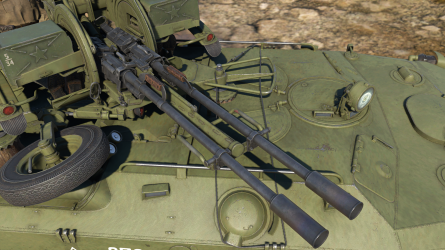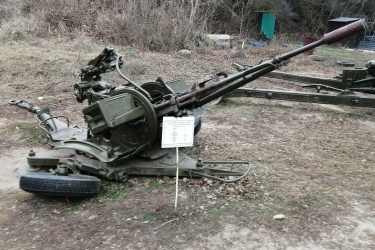ZU-23 (23 mm)
Contents
Description
The 23 mm ZU-23 is a Soviet anti-aircraft gun, most often paired in a towed, stationary twin gun mount, designated ZU-23-2. This weapon was first developed in the 1950s as a point-defense measure against low-flying aircraft and light armored targets.
The ZU-23-2 was adopted for use by the Soviet Union in 1960 and continued to serve into the present day, even outlasting the nation that created it. Over the many years that the weapon had been in service, it was widely exported, becoming a ubiquitous heavy weapon found in conflicts in the Middle East, Asia and Africa. During the Vietnam War, ZU-23-2s were responsible for large amounts of American casualties and aircraft losses.
In order to increase the mobility of the weapon, armies in possession of ZU-23-2 turrets began mounting them to vehicles in an ad-hoc fashion. One of the most infamous of these combinations was the "technical", an improvised fighting vehicle usually comprised of a ZU-23-2 turret mounted on the bed of a civilian pickup truck. Some armies with larger budgets and greater manufacturing capabilities opted to create similar vehicles, albeit more professionally.
Over time, this weapon system would become less and less effective against jet aircraft, which were significantly increasing in speed. However, armies would continue to use the weapon effectively against low-flying helicopters and light and unarmored ground targets.
Vehicles equipped with this weapon
- Ground vehicles
- Naval vessels
General info
The 23 mm ZU-23 is an excellent anti-aircraft weapon due to its ballistics and caliber, which can make aiming easier due to not needing to lead targets as much. High-explosive rounds carry a significant amount of explosive filler, meaning that glancing shots may be able to tear off aircraft wings and set components on fire. In the ZU-23-2 twin gun mount, this turret is able to do twice the damage against enemy targets.
Using armor-piercing rounds, these weapons can easily shred through lightly armored ground targets and even some medium targets from the side. Because of the caliber, the 23 mm ZU-23 may not do significant damage against heavily armored targets. However, exposed modules such as gun barrels and tracks will still take significant damage.
Available ammunition
- Default: API-T · HEF-I
- HEFI-T: HEF-I · HEFI-T · HEF-I · API-T
- APIT: API-T · API-T · API-T · HEFI-T
| Penetration statistics | |||||||
|---|---|---|---|---|---|---|---|
| Ammunition | Penetration @ 0° Angle of Attack (mm) | ||||||
| 10 m | 100 m | 500 m | 1,000 m | 1,500 m | 2,000 m | ||
| HEF-I | 6 | 6 | 4 | 3 | 2 | 2 | |
| API-T | 51 | 48 | 36 | 26 | 18 | 13 | |
| HEFI-T | 6 | 6 | 4 | 3 | 2 | 2 | |
| Shell details | ||||||||||||
|---|---|---|---|---|---|---|---|---|---|---|---|---|
| Ammunition | Velocity (m/s) |
Projectile mass (kg) |
Fuse delay (m) |
Fuse sensitivity (mm) |
Explosive mass (TNT equivalent) (g) |
Ricochet | ||||||
| 0% | 50% | 100% | ||||||||||
| HEF-I | 980 | 0.18 | 0.1 | 0.1 | 28.49 | 79° | 80° | 81° | ||||
| API-T | 970 | 0.19 | - | - | - | 47° | 60° | 65° | ||||
| HEFI-T | 970 | 0.19 | 0.1 | 0.1 | 20.02 | 79° | 80° | 81° | ||||
Comparison with analogues
Give a comparative description of cannons/machine guns that have firepower equal to this weapon.
Usage in battles
The 23 mm ZU-23 cannon is most often dual-mounted, and has a very high rate of fire, making it very effective against aircraft. The canon also has decent penetration, so it can take out many ground vehicles, except from the most heavily-armoured ones.
Pros and cons
Pros:
- High rate of fire
- HEF-I and HEFI-T rounds can inflict critical damage to aircraft
- API-T rounds can punch through lightly armored ground targets
- Excellent ballistics
Cons:
- Long reload time
- High fire rate causes magazine to empty quickly
- Ineffective against fast aircraft outside of its ~3 km effective range
History
In 1954, the Soviet Union's Chief Directorate of the Missile Troops and Artillery GAU issued an order to the design bureau TsKB-14 (located in Tula) to develop a new anti-aircraft weapon that was larger than the 14.5 mm caliber and more transportable than the 37 mm M1939 gun.[1] TsKB-14 designer Nikolay M. Afanasev, who was already working on upscaling his 12.7 mm A-12.7 aircraft machine gun to a 23 mm caliber, submitted his prototype weapon chambered in the 23x152 mmB cartridge used in the VYa cannon (the cartridge modified to use steel case with a sturdier extractor rim). The cannon design was accepted for Soviet service under the GRAU index number 2A14 and began production at plant No.535 in Tula.[1]
The 2A14 cannon was envisioned to be used in single, twin, and quadruple-mount carriages. In February 1955, TsKB-14 designers E.K. Rachinskiy and R.Ya. Purtsen would produce the ZU-1 single mount and the ZU-14 twin-mount carriages for the 2A14, with evaluations for the designs held between April and September 1956. While the ZU-1 was eventually dropped due to its relatively high weight of 440 kg, the ZU-14 proved more successful at 950 kg fully loaded with the ability to transition from travel to combat configuration in up to 20 seconds (the weapon can still fire in the travel configuration). An automatic anti-aircraft sight ZAP-23 was also installed to help target aircraft flying up to 300 m/sec. Following troop trials in 1959, the ZU-14 was adopted in 1960 as the ZU-23 "Konkurent", with index number 2A13. A quadruple mount would also be developed from the 2A14; the gun was modified and was put in a self-propelled mount as the AZP-23.[1]
The ZU-23 saw prominent service in the Soviet infantry units, notably in the airborne as the weapon was light enough to be air-droppable and has similar anti-aircraft firepower to a ZSU-23-4 "Shilka".[2] A Soviet airborne division would have a battalion of 18 ZU-23s, splitting into batteries of six ZU-23s that are attached to an airborne brigade.[3] The ZU-23 can provide an effective anti-air range of 2,500 metres, fed by linked ammunition of 50 rounds from boxes attached to the outside of each cannon's trunnion. The ZU-23 also saw use in Soviet motorized rifle regiments that have not yet converted to missile and ZSU-23-4 air defense, and as close air defense for SA-4 brigades.[2][3]
Media
- Videos
See also
- Related development
- AZP-23 (23 mm) - (Same caliber cannon found in a quad mount on the ZSU-23-4)
- PG87 (25 mm) - (Chinese reverse-engineered re-calibered ZU-23 to 25 mm)
- Weapons of similar design and role
External links
References
- Citations
- Bibliography
- Department of the Army. 1991. FM 100-2-3: The Soviet Army - Troops, Organization, and Equipment. Washington DC: US Government Printing Office.
- Koll, Christian. 2009. Soviet Cannon: A Comprehensive Study of Soviet Guns and Ammunition in Calibres 12.7MM to 57 MM. Austria: self-published.
- Pike, John and Robert Sherman. 2000. "ZU-23 23MM Antiaircraft Gun". FAS Military Analysis Network. Last modified April 27, 2000. Website (Archive)
| Germany naval cannons | |
|---|---|
| 15 mm | MG 151 |
| 20 mm | 2 cm/65 C/30 · 2 cm/65 C/38 · 2 cm/65 Flakzwilling 38 · 2 cm/65 Flakvierling 38 · MG 151/20 |
| 30 mm | MK103/38 |
| 37 mm | FlaK-Lafette C/36 · 3.7 cm FlaK-Lafette LM/42 · SK C/30 · FlaK.36 · FlaK43 |
| 40 mm | 40 mm/70 MEL58 · Bofors Flak 28 · Bofors L/70 model 1948 |
| 52 mm | 52 mm/55 SK L/55 |
| 88 mm | 8.8 cm/76 SK C/32 · S.K.C/35 · FlaK.18 · Flak.36 · 88 mm/45 AA SK L/45 · 88 mm/45 casemate SK L/45 |
| 100 mm | 100 mm/55 MLE model 53 |
| 105 mm | SK C/32 · SK C/33 AA |
| 120 mm | L45 |
| 128 mm | 12.8 cm/45 SK C/34 · 12.8 cm SK C/41 |
| 150 mm | 150 mm/45 SK L/45 · 15 cm/48 KC/36 · 15 cm/55 SK C/28 · 15 cm/60 SK C/25 |
| 203 mm | 20.3 cm/60 SK C/34 |
| 283 mm | 283 mm/45 SK L/45 · 283 mm/52 SK C/28 · 283 mm/54,5 SK C/34 |
| 305 mm | 305 mm/50 SK L/50 |
| 380 mm | 38 cm SK L/45 |
| Foreign: | |
| 23 mm | ZU-23 (USSR) |
| 25 mm | 2M-3 (USSR) |
| 30 mm | AK-230 (USSR) |
| 37 mm | V-11 (USSR) |
| 76 mm | 76 mm/62 OTO-Melara Compact (Italy) |
| 100 mm | 100 mm/56 B-34 (USSR) |
| Britain and USA anti-aircraft guns | |
|---|---|
| 7.92 mm | BESA |
| 12.7 mm | M2HB |
| 20 mm | GAI C01 · M168 · Oerlikon Mk.II · Polsten |
| 25 mm | GAU-12U |
| 30 mm | HSS 831L |
| 35 mm | GA-35 |
| 37 mm | M1A2 |
| 40 mm | Bofors L/60 · Dual Automatic Gun M2 · M266 |
| Foreign: | |
| 23 mm | ZU-23 (USSR) |
| 35 mm | Oerlikon KDA (Swiss) |
| USSR anti-aircraft guns | |
|---|---|
| 7.62 mm | Maxim's |
| 12.7 mm | DShK |
| 14.5 mm | KPVT |
| 23 mm | AZP-23 · ZU-23 |
| 25 mm | 72-K |
| 30 mm | 2A38 · ZK453 |
| 37 mm | 2A11 · 61-K · Sh-37 · Type 65 |
| 57 mm | S-68 |





